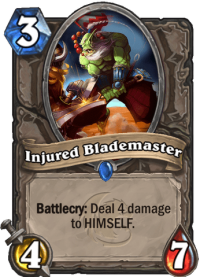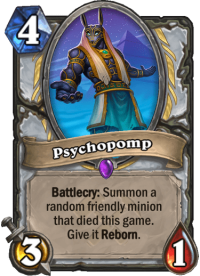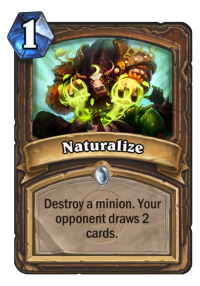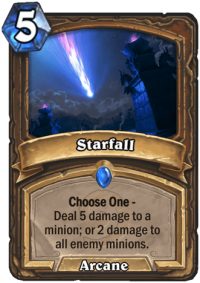There are many aspects of the Developer Insight post about class identity worthy of discussion. In that post, the Hearthstone development team outlined their philosophy and vision for what classes are and are not supposed to be good at doing. As such, the most common discussions people will talk about focus on how class X or Y doesn’t stick to its outlined strengths/weaknesses.
Those are discussions worth having, but I wanted to talk more today about a passage from that post that gets less attention. That passage reads:
“Giving classes better defined characteristics allows us to have more freedom when creating new mechanics. We can push further into the extremes knowing that each class has downsides to balance out new power”
That has long worried me. While the prospect of getting powerful and exciting new archetypes and cards can bring interest to the game, it’s not without risks. Pushing extremes of power can break the game or polarizing it heavily. If one class is pushed too far and dominates or one class isn’t pushed as much and falls out of the meta, that can generate negative experiences. Moreover, if classes all have well-defined strengths and weaknesses, queuing into a class who does something yours can’t deal with might turn games into ones where it feels like things were over before they began.
With that in mind, let us examine how some of these extremes of design play out in practice. We want to see what happens when powerful themes are explored to an extreme degree. We will look at two cases: Priest and Druid. Remember: this isn’t about whether these classes or cards needs balance changes. We just want to more fully appreciate what extremes in design actually look like.
Is Somebody Injured?

Back in the days of early Hearthstone, Injured Blademaster and Circle of Healing used to be a core part of many Priest decks. It provided Priest with a powerful tempo-generating combo, but it also involved a few weaknesses. Chief among these was that your deck only played two copies of Circle/Blademaster, making the combo inconsistent. Further, there were tradeoffs that had to be considered as, given your limited numbers of Circles, if you used a copy on a Blademaster, you now couldn’t use that same copy for a Northshire Cleric/Wild Pyromancer combo, or for a board clear with Auchenai Soulpriest.
In that version of Priest resources were limited and things weren’t always consistent. Despite that, I had fond memories of playing the deck. It felt tricky to play, as if you were solving little puzzles each game about how to use these conditional and unusual cards. Now let’s look at the new version of Priest. It seems that Blizzard was true to their design philosophy, taking something a class used to do and pushing its power level up to explore the extremes of that theme. In this new deck, you are now packing an additional copy of Blademaster (in the form of Injured Tol'vir) and an additional copy of Circle of Healing (in the form of Neferset Ritualist). Having these copies improves your consistency substantially, which the presence of each new card making the presence of the old cards better: Circle makes Tol’vir better, while Ritualist makes Blademaster better. All of them make combos with Northshire Cleric and Divine Spirit more consistent.

Things get even more powerful than that due to the addition of Psychopomp. If you have had either of your Injured minions die, Psychopomp can act as another copy of Tol’vir/Blademaster and Circle in one card. This allows you to play faster and looser with your injured minions, not requiring a combo on the turn you drop them to gain your tempo; just play one on the board without a heal and you’ll fine because their dying can be a benefit when you resurrect them. Psychopomp can be even better than that, though, as the Reborn text makes these minions even harder to fully kill. If they don’t die twice on the opponent turn, this opens yet another opportunity for a Circle combo, Divine Spirit, or Cleric to do work.
The redundancy here leads to great power. Priest decks went from running only two copies of Blademaster/Circle combo to roughly six, all things considered. I would say that qualifies as exploring the extremes of a strategy, but a question remains as to whether that makes the deck/playstyle more interesting. When a deck is almost always doing the powerful things, it makes the play patterns feel similar. Instead of solving little puzzles or making difficult decisions with limited and conditional resources, you do the same basic powerful thing repeatedly.
Ironically, this increase in consistency led to a breakdown of the Priest class identity. As outlined in the “strengths” section, Priest is supposed to be a class of narrow but useful spells. Narrow, in this context, means conditional; cards that aren’t always useful. This is what made Divine Spirit/Inner Fire decks weak in the past: the power level of cards when they worked didn’t make up for all the time they sat dead in the hand not working. Increasing the consistency of these cards – whether through tutors like Shadow Visions or through almost always having access to a target for them because you’re playing six Blademasters and High Priest Amet – makes them less “narrow”. By exploring an extreme of the Blademaster style of deck, a key identity of the class was bypassed.
To me, that lacks the same kind of charm that Priest used to have.
“Moving [Naturalize] to the Hall of Fame enforces Druid’s Weakness in removing large minions…”

When Naturalize got moved to the Hall of Fame, we got the above justification for the decision. As the insight clearly states, Druid is supposed to be weak at removing large minions. The removal of Naturalize from Standard play should have allowed the design team to explore the extremes of what Druids can do in other regards, as a weakness had been enforced. That’s the theory, anyway.
One of the most recent explorations of those extremes has been the “Choose One” mechanic. In this case, we got the exceptionally-consistent Untapped Potential Druid Quest that turns all the Choose One cards into Choose Both as a passive. Doing that results in extremely good cards. Ironically, this has made Druid very, very strong at single target removal. Let’s consider quickly what powerful single-and-not-so-single-target removal they now have access to:
- Swipe: A Druid staple with a solid power level
- BEEEES!!!: A fairly average power level removal, but effective enough.
- Wrath: While good on its own, with the Quest it turns into 2 mana deal 4 and draw a card, which is better than most options in the game for the cost.
- Starfall: 5 mana deal 7 damage to 1 target and 2 to all others, making it premium single-target removal and AoE (another Druid weakness).
- Wardruid Loti: With Rush and Poisonous, for 3 mana you get removal and a powerful body. The spell damage makes the above removal options even better.
- Oasis Surger: 5 mana for 10 Rush damage that can be divided into 2 attacks qualifies both as powerful single-target removal options and a proactive threat. Comparing this to the 12-mana Hunter would have to spend for both copies of Unleash the Beast makes the power level here clear.
- Other copies of these cards that can be discovered off Worthy Expedition or with Flobbidinous Floop‘s transformation
Though none of those cards outright say “Destroy” as Naturalize did, all of them range from quite efficient to absurdly powerful when it comes to serving as single- and/or multi-target removal. Some are threats as well, making them even better. Collectively, those cards can make up approximately a third of the Druid’s deck. It certainly doesn’t sound like a class weakness that’s been enforced consistently.

In this exploration of “Choose One” extremes, we end up in a world where both the effect itself ceases to mean anything (there is no “choosing” happening anymore, removing the interesting part of the cards) and Druid begins to break down a class weakness it was supposed to have (weak single-target removal). This is particularly ironic, as in the Developer Insight post, these class weaknesses are used as the justification for exploring these extremes, and the extremes, in turn, helped undo the class weakness.
In my mind, I always liked Naturalize as a card because it was weak single-target removal. Giving your opponent two cards was typically a large downside to the point that, until the invention of Ultimate Infestation and Spreading Plague, almost no competitive Druid decks ran Naturalize. Much like how Priest used to only have access to two copies of Circle of Healing – reducing consistency and creating tradeoffs – Naturalize used to present a tradeoff as well, where you got good tempo removal at the cost of giving your opponent card advantage. However, with the new Druid Quest, there are no more tradeoffs to the Choose One cards; they just all become too powerful.
Fandral Staghelm was similarly interesting. You couldn’t just play any Choose One cards you wanted with him in the same deck because you might not draw him or have the mana to play both in the same turn. You could try to just play him on a previous turn and hope he stuck, but that was by no means guaranteed. Again, it feels like the extremes of design being explored are leading to less interesting decisions and a lower overall charm level to a deck. Having a card that explored a theme Druid wasn’t supposed to be good at in a novel way – like Naturalize – strikes me as attention-grabbing.
Moving Forward
I’d encourage you to think about these issues not in terms of power level or whether card X or Y needs a balance change, but rather in terms of how these extremes in terms of designs feel. If this design philosophy is followed in the future, we can expect more decks that operate under these principles: they will begin to do these powerful things more consistently than decks of the past.
Though I can’t speak for every player, I can at least say that, for me, these new decks don’t feel as engaging as those of previous generations. They are less about making what you have work and more about simply executing the exact same game plan over and over. When resources are more limited, decisions begin to become more meaningful.

I think the biggest challenge right now is that the HS community has just gotten so good at min/max’ing their decks for the highest win rates. For instance: I actually think priest OVERALL is in a fairly weak spot right now. The new quest archetype is fun but too slow to be competitive, and the resurrection, wall, and Nomi archetypes that were borderline OK in RoS have all fallen off since SoU. The single exception is this aggro/combo archetype, which ~8% of players play and has a win rate of ~55%–and its literally made by incorporating all the best set pieces from the other archetypes and dropping the rest. Injured Tolvier and Neferset Ritualist were made to supplement the new quest. Psychopomp was intended for resurrection and wall. Bwonsamdi was intended for Spirit of the Dead shenanigans. None of them are ladder-worth on their own, but someone discovered you could mix them all together along with Lightwarden/Cleric/Divine Spirit/etc to create a very successful hybrid, and then everyone else quickly copied them.
Regarding incorporate “class downsides” to balance out this archetype: all you can really do is nerf Cleric. Otherwise, Cleric and Acolyte provide ample card draw, and face damage and multi-minion buffs are irrelevant to your win condition. Nerfing Cleric would hinder this archetype at the cost of totally cripping every other priest deck. And if they did: all these priest players would just netdeck whatever the 2nd most successful aggro deck is (currently Murloc Shaman, but Tip the Scales Paladin and Aggro Warrior are close behind), so other than seeing different cards the overall meta wouldn’t change much.
It’s an odd conundrum we find ourselves in. I remember how the Year of the Raven had become stale since all most cards did was feed the classes with the best Baku/Genn decks. But at least you could craft those two legends and know that for the Year of the Raven, you were more or less set. This time… well, if you hadn’t gone all in with crafting your Control Warrior tools, your Combo Priest pieces, or other cards nobody realized could be useful (I’m pretty sure nobody ran the Bwonsamdi/Talanji combo), you’re crippled with a subpar deck.
I’m honestly rather bummed that as much as the newer quests are easier(?) to complete, they mostly haven’t had the groundbreaking impact the originals had. They’re straddling that awkward place between “gets run over by aggro” and “eventually loses to control”. No kidding, this is the most expensive era of Hearthstone. In retrospect, it makes Team 5 charging 2.8k gold and 2.1k gold for the respective solo player content all the more annoying.
Great article, completely agree.
Great article, i fully agree. I don’t want superpowers and superweakness, i just want the player to have more influence over the game, by having more options and hard decisions, but i often feel we are going in the opposite direction and HS looks more like a film that a game.